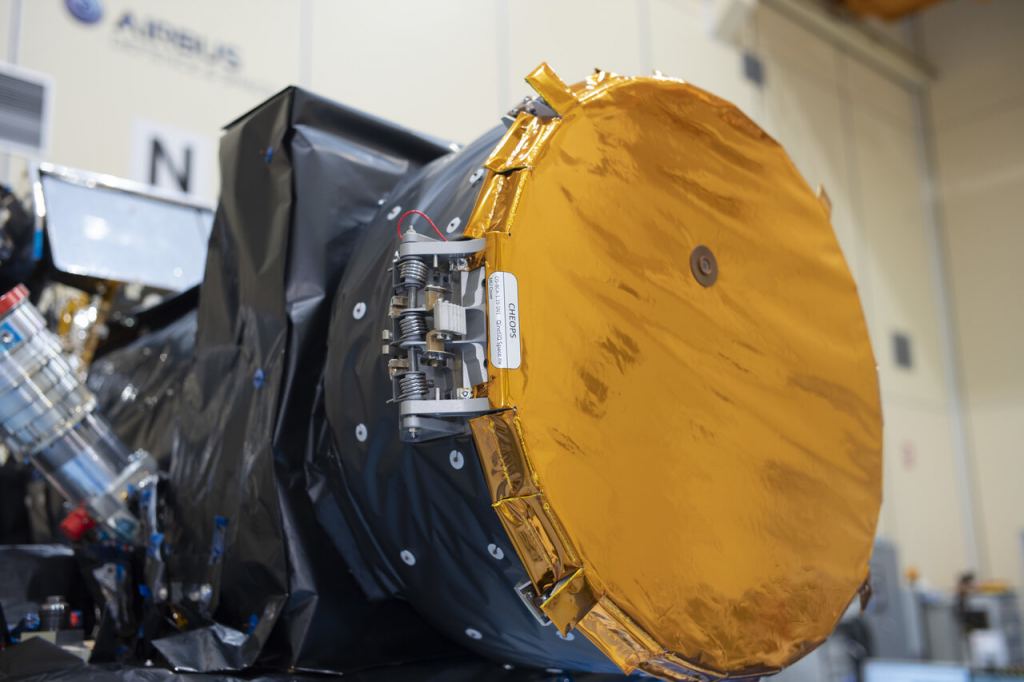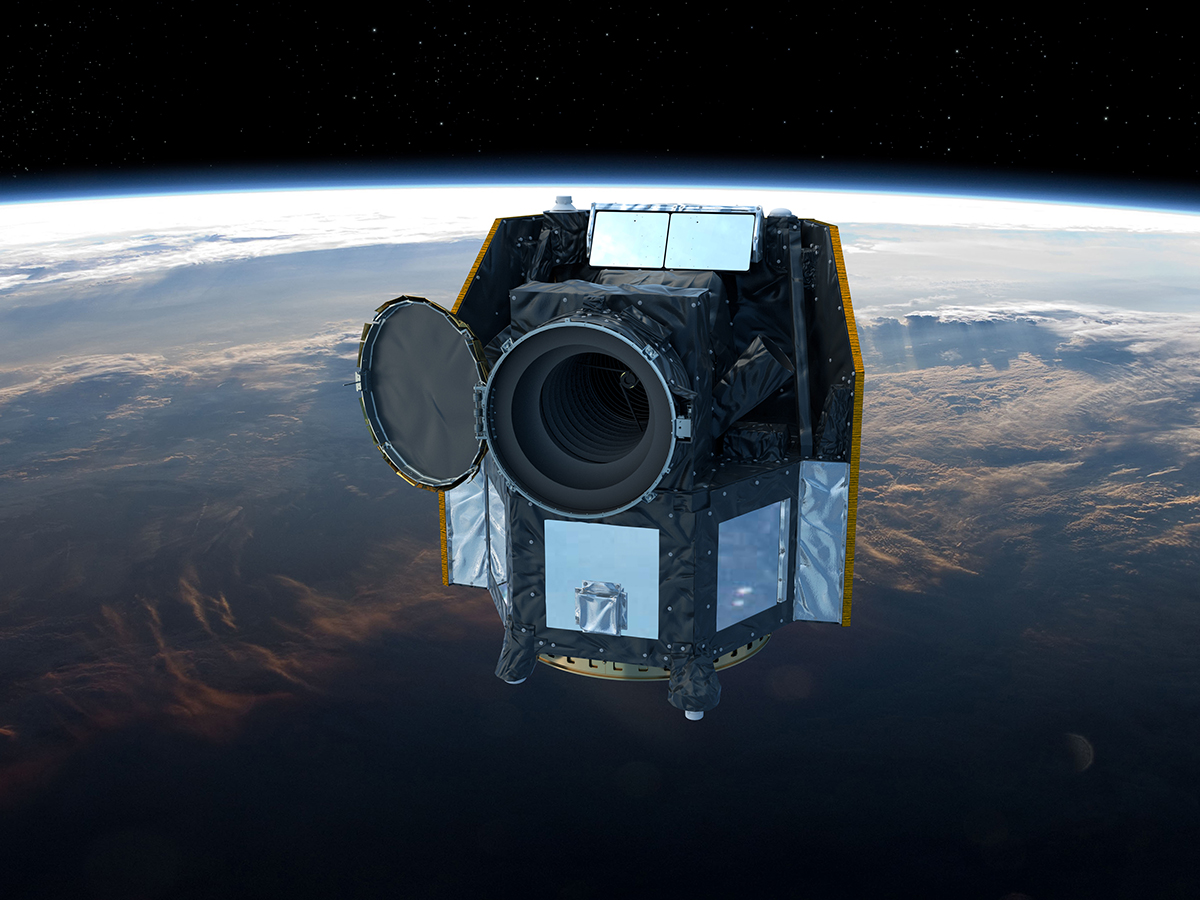The CHEOPS (CHaracterising ExOPlanets Satellite) spacecraft just opened the cover on its telescope. The spacecraft was launched on December 18th 2019 and has so far performed flawlessly. In one or two weeks we could get our first images from the instrument.
CHEOPS is an ESA mission in partnership with Switzerland’s University of Bern. Its mission is not to find exoplanets, but to look more closely at stars with known exoplanets, and to watch as those planets transit in front of their star. It will watch those transits with a keen eye, and will determine the size of those planets with greater accuracy and precision. That will lead to better measurements of their mass, density, and composition.
“… we expect to be able to analyze and publish the first images within one or two weeks.”
David Ehrenreich, CHEOPS project scientist, University of Geneva
“Shortly after the launch on December 18, 2019, we tested the communication with the satellite. Then, on January 8, 2020, we started the commissioning, that is, we booted the computer, carried out tests, and started up all the components,” explains Willy Benz, professor of astrophysics at the University of Bern and Principal Investigator of the CHEOPS mission.
“All the tests went outstandingly well,” he says. “However, we were now looking forward excitedly and with a bit of nervousness to the next decisive step: the opening of the CHEOPS cover,” continues Benz.
The cover was opened at 7:38 AM on Wednesday, January 29, 2020. The Mission Operation Center at the Instituto Nacional de Técnica Aeroespacial (INTA) in Madrid sent the command for the spacecraft to open up.
“Opening the cover of the telescope baffle is a critical operation for Cheops, enabling the telescope to observe its target stars, and we are extremely pleased that it was performed flawlessly,” said Nicola Rando, ESA Cheops project manager.

The opening of the cover signals the start of another round of testing and calibration. The telescope took hundreds of pictures while the cover was on as part of instrument calibration, and for the next phase of testing, CHEOPS will look at both stars with exoplanets and stars without.
“In the next two months, many stars with and without planets will be targeted in order to examine the measurement accuracy of CHEOPS under different conditions,” Benz explains.
This phase is also important for ground crew at the Mission Operation Center. It gives them a chance to train on all aspects of ground operations.
“The raw data of CHEOPS are being processed in the so-called data reduction pipeline,” says David Ehrenreich, CHEOPS project scientist at the University of Geneva. Ehrenreich explains: “The complete assessment of the abilities of CHEOPS and the ground segment will take some time. However, we expect to be able to analyze and publish the first images within one or two weeks.”
CHEOPS is one of the ESA’s new S-Class (Small Class) missions. These are missions with budgets limited to $50 million euros. CHEOPS is the first of these missions, and the Solar wind Magnetosphere Ionosphere Link Explorer (SMILE), a joint effort with China, will be the next one.
There are two primary methods of detecting exoplanets. The Kepler Mission and the TESS mission employ the transit method. The transit method refers to an exoplanet travelling, or transiting, in front of its star from our perspective. The minute dip in starlight can be detected, and then confirmed by other telescopes.
The other method, and the first method to discover an exoplanet, was the radial velocity method. This method focuses on the star, and detects tiny wobbles in its motion as an orbiting exoplanet tugs on it. It’s also known as Doppler spectroscopy.
A third method is direct observation, but only a few have been directly observed.
The transit method gives a good indication of the size of an exoplanet, but not its mass. And the radial velocity method can give a good indication of a planet’s mass, but not its size. Few of the 4,000 exoplanets that we know of have accurate data for both size and mass. That makes it difficult to determine their density, and their composition. Knowing these things will help determine how they formed, and will also shed light on how our planet and Solar System came to be.
CHEOPS will observe exoplanet-hosting stars to measure the small changes in their brightness due to a planet’s transit. The information will enable accurate and precise measurements of the sizes of the orbiting planets. CHEOPS will target stars hosting planets in the super-Earth to Neptune size range. By combining sizes with existing ground spectroscopy measurements of the planet masses, CHEOPS will provide an estimate of bulk density – a first step towards characterizing planets outside our Solar System.
During its 3.5-year mission, CHEOPS will look at the brightest nearby stars that are known to host exoplanets.
CHEOPS will be able to characterize these exoplanets with a new level of precision. These CHEOPS’ results will lead to further follow-up observations in the future by telescopes like the James Webb Space Telescope, and by large ground-based telescopes like the 40-meter Extremely Large Telescope currently under construction. The James Webb’s infrared capabilities will also allow detailed study of exoplanet atmospheres.
CHEOPS is orbiting Earth’s poles at an altitude of 700 km. It’s in a Sun-synchronous orbit and follows the terminator. It’s also called a dawn-dusk orbit, and the spacecraft will always point itself toward Earth’s night side. This will limit the effect of direct sunlight, and sunlight reflected off Earth, on the spacecraft’s measurements.
CHEOPS is a pretty simple instrument at its heart. It’s a type of telescope called a Ritchey-Chretien telescope, and it has a 32 cm (12 inch) aperture. The telescope is passively-cooled to a temperature of -40 Celsius. The spacecraft is powered by solar panels that also act as the Sun-shield.
80 % of CHEOPS observing time will be spent on the CHEOPS Guaranteed Time Observing (GTO) Programme. That means it will spend 80% of its time looking at known exoplanets, which will make its operation very efficient.
“By targeting known systems, we know exactly where to look in the sky and when in order to capture exoplanet transits very efficiently,” says Willy Benz, CHEOPS principal investigator at the University of Bern, Switzerland. “This makes it possible for CHEOPS to return to each star on multiple occasions around the time of transit and record numerous transits, thus increasing the precision of our measurements and enabling us to perform a first-step characterization of small planets – in the Earth-to-Neptune size range.”
The remaining 20% of observing time will be made available to the wider astronomy community.
More:
- Press Release: Cover of CHEOPS Space Telescope Open
- ESA: CHEOPS Science Objectives
- Universe Today: ESA’s CHEOPS Just Launched. We’re About to Learn a LOT More About Exoplanets

